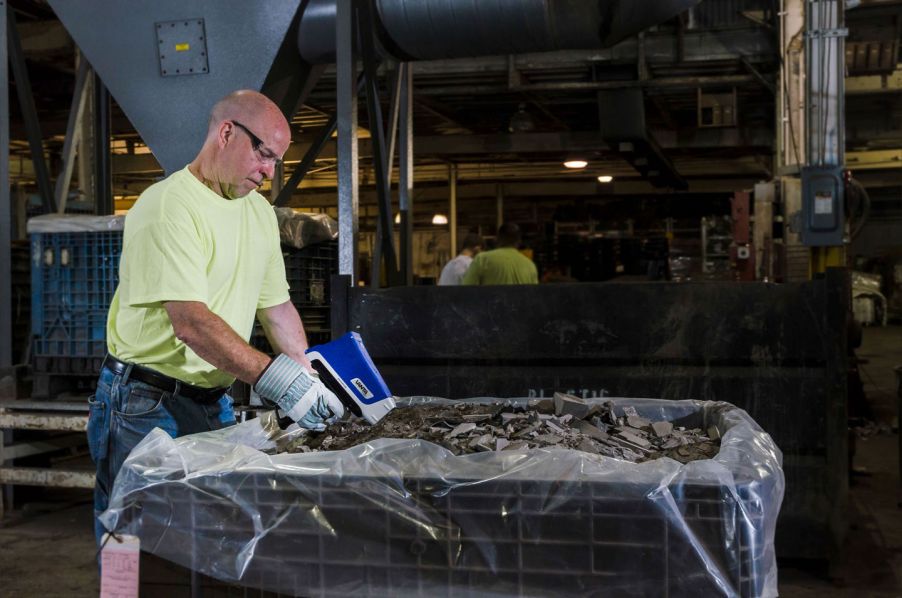A catalytic converter is a device that helps your car produce cleaner emissions. It does so by using a catalyst—a substrate that accelerates a chemical reaction—to turn harmful gases from the exhaust system into less polluting ones. This device can also help the environment in another way—through recycling.
In addition to reducing waste, recycling catalytic converters is economically profitable because of the rare metals found inside them. The catalyst component inside the catalytic converter is typically a combination of platinum (Pt), palladium (Pd), and rhodium (Rh)—all rare and costly platinum group metals, or PGMs.
With proper sorting and processing of catalytic converter scrap, these metals can be recovered and reused to manufacture new catalytic converters and other equipment.
Identifying Platinum Group Metals in Catalytic Converter Scrap Using Handheld XRF
Recycling facilities need a fast, accurate method to identify these sought-after metals at multiple steps of the recycling process.
One helpful tool is the handheld X-ray fluorescence (XRF) analyzer, which can provide on-site elemental analysis of catalytic converter scrap for quick sorting and pricing. While handheld XRF such as the Vanta™ series can provide answers fast, it is important to follow best practices for your analyzer to help ensure proper performance.

A technician uses a handheld XRF analyzer to test catalytic converter scrap at a recycling facility
To optimize your Vanta handheld XRF for faster testing and accurate measurements of Pt, Pd, and Rh in catalytic converter recycling, follow these quick tips:
Check your instrument window.
First, check that the correct window is installed on your handheld XRF analyzer. For instance, we offer different instrument windows depending on the Vanta model and type of X-ray tube.
Another important consideration is the condition of the window. Is it intact? Check your window for any signs of puncture or tears. If you see any holes, it is time to replace it.
It is also vital that the window is clean for the analyzer to work properly. Before testing, make sure that you clean the window with alcohol or a wet wipe.
Properly prepare your samples for testing.
For the most representative and accurate results, we recommend you grind, sieve, and homogenize the spent catalysts to properly prepare them for XRF analysis. Combine the analyzer with the portable Vanta Work Station to take PGM measurements in a fully interlocked system.
Sort scrap materials by grade ranges.
Before homogenizing the spent catalysts, recyclers should use the Vanta analyzer to sort and separate materials of the same type. Sort into three or four grade ranges, such as:
- Oxygen sensors
- Three-way converters
- Two-way converters
- Diesel particulate filters (DPF)
Check your test times.
When testing PGMs in car catalytic converter scrap, it’s important to make sure that your test times are correct.
Here are some recommended test times:
- Fastest scan for Pt, Pd, Rh: Beam 1—max. 15 seconds. A good choice for basic sorting and detecting the presence of PGMs and tantalum (Ta) and selenium (Se) additions.
- Standard testing for Pt, Pd, Rh: Beam 1—max. 30 seconds, Beam 2—max. 15 seconds. Ideal for fully prepared samples sent to refineries.
- Full scan for all elements: Beam 1—max. 45 seconds, Beam 2—max. 15 seconds. Can be used within refineries to optimize recovery processes.

Recommended test times for measuring Pt, Pd, and Rh with the Vanta handheld XRF analyzer
Discover More XRF Tips for Catalytic Converter Recycling
As the global need for PGMs grows rapidly (analysts predict the global PGM market will grow at a CAGR of 4.38%), catalytic converter recyclers will need to work efficiently to keep up with the demand. These XRF tips can help streamline your process throughout the recycling circuit.
To discover more tips for using handheld XRF in catalytic converter recycling, check out our free car cat webinar.
Related Content
How Vanta Analyzers Make Car Catalyst Recycling More Efficient
Webinar: Automotive Car Catalyst Recycling with Vanta Handheld XRF
Infographic: Vanta for Car Catalyst Analysis
Get In Touch


.jpg?rev=4066)